by Akito Konishi
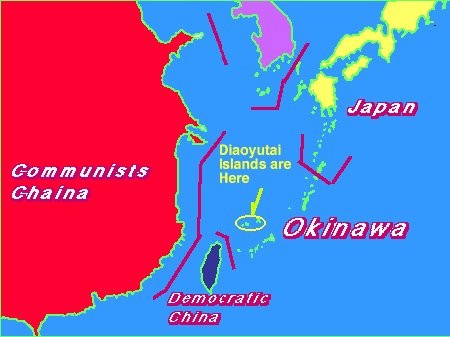
Map Showing location of Okinawa
The island groups of Okinawa are very important to the Japanese. They are Japan's most southwestern prefecture (State), consisting of 50 inhabited islands and 110 uninhabited islands scattered over an area 1,000 km (from east to west) by 400 km (from north to south). The Okinawa Prefecture is located between Kyusyu and Taiwan. The islands are divided into three major groups: the Okinawa Island Group, the Miyako Island Group, and the Yaeyama Island Group. Okinawa Island is by far the largest, followed in turn by Iriomote Island, Isigaki Island, and Miyako Island.
Toward the end of World War II, the United States of America attacked this important Japanese island. The Americans needed Okinawa to be able to stage their final attack on the main islands of Japan. The strategic placement of the Island of Okinawa meant that it was easier for the American bombers to reach Japan.
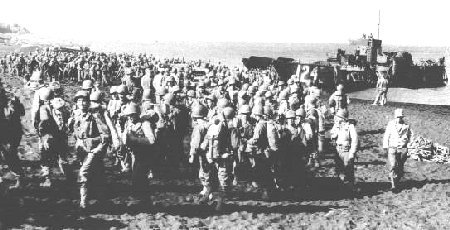
Americans land on the Coast of Okinawa
On April 20, 1945, the United States Marines made an amphibious landing on Okinawa. The Japanese had 40,000 soldiers on this island determined to stop the Americans by fighting to the death. This meant that the Americans would have to kill almost every Japanese soldier who refused to surrender before they could take Okinawa. In the process the Japanese tried to kill as many American soldiers as they could. Unfortunately, the Japanese soldiers also killed or hurt many Okinawa civilians, which meant that they were really hurting their own people.
On May 24, 1945, the Marines took Naha, the capital city of Okinawa. It was the largest Japanese city that the Marines had ever taken up to that point. On June 10, the American generals sent a message to the Japanese with terms of surrender, but the Japanese generals never responded. The fighting continued for another five days until the coordinated Japanese resistance ended. Only 1,000 Japanese soldiers survived the fighting. By June 21, 1945, the island of Okinawa was secured. On June 23, the two generals in charge of the Japanese forces, Generals Ushijima and Cho Isamu, both committed suicide.
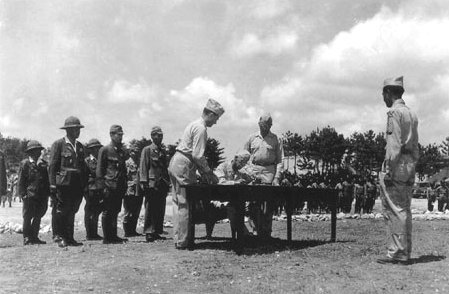
Japanese Generals sign cease-fire
Okinawa was to remain an American territory from 1945 to 1972. After Japan surrendered in 1945, Secretary of State Dean Acheson and the Secretary of Defense Louis Johnson made it a goal that the United States retain exclusive strategic control of the islands.
In 1951, at the San Francisco Peace Conference, the United States returned some control of the islands to Japan. At that conference, John Foster Dulles, representing the American State Department, publicly announced that although Japan would be given "residual sovereignty" over the islands, the United States would continue to keep a military presence on the island.
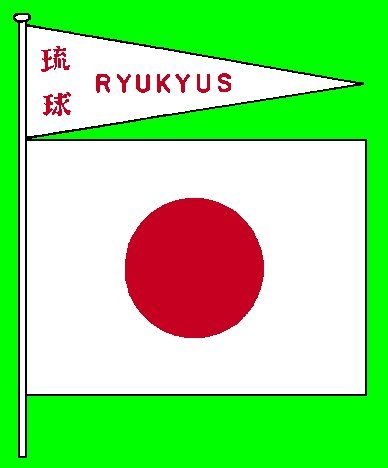 This is the new flag of Okinawa. |
In 1954, President Eisenhower gave his State of the Union Address during which he declared "We shall maintain indefinitely our bases in Okinawa."
That policy has continued to this very day. The United States still maintains military bases on Okinawa, but the island and the people there are now considered to be Japanese Nationals. The United States pays rent to Japan for the use of the land for the bases.
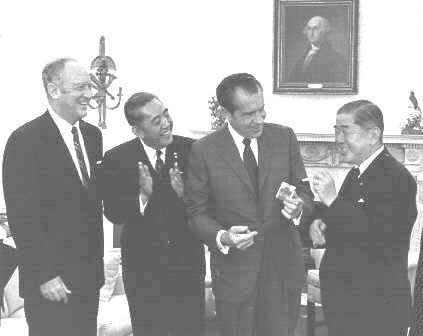
President Nixon offers the Japanese ambassador a cigarette.
The ambassador had quit smoking until the issues regarding Okinawa were resolved.
SOURCES:
"The American Years, 1945~1972" @ http://faculty.tamu-commerce.edu/pphotos.htm/ , 5/04/00.
Picture #1 - "Map of Okinawa" from: http://faculty.tamu-commerce.edu/sarantakes/Photos.html
Picture #2 - "American military land on the coast of Okinawa" from: http://faculty.tamu-commerce.edu/sarantakes/Photos.html
Picture #3 - "Japanese General signs cease-fire" from: http://faculty.tamu-commerce.edu/sarantakes/Photos.html
Picture #4 - "This is the flag of Okinawa" from: http://faculty.tamu-commerce.edu/sarantakes/Photos.html
Picture #5 - "President Nixon offers the Japanese ambassador a cigarette." from: http://faculty.tamu-commerce.edu/sarantakes/Photos.html